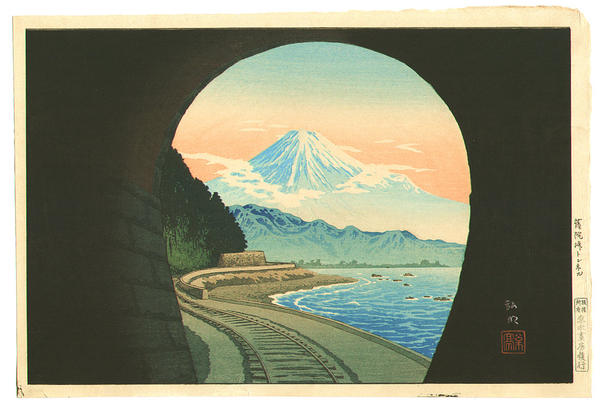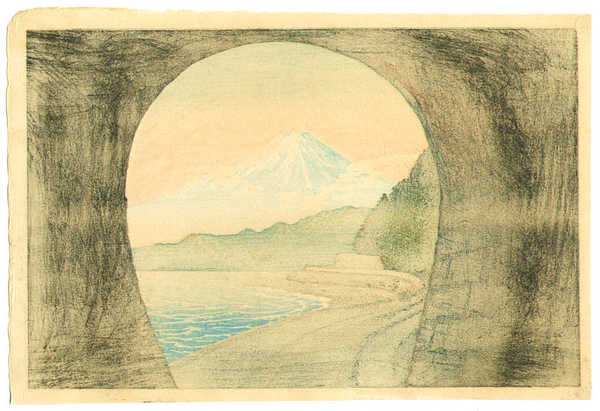| | |
| Artist: | Shotei Takahashi (1871-1945) Hiroaki — 松亭高橋、弘明 |
| Title: | Satta Mountain Pass Tunnel |
| Series: | Four Seasons of Mt Fuji — 四季乃富士 |
| Date of first edition?: | 1929-1932 |
| Date of this artwork?: | 1929-32 (may not be accurate) |
| Publisher (first edition)?: | Fusui Gabo |
| Publisher (this edition)?: | Fusui Gabo |
| Medium (first edition): | Woodblock |
| Medium (this edition): | Woodblock |
| Format (first edition): | Oban
|
| Format (this edition): | Oban |
| DB artwork code: | 39655 |
| Notes (first edition)?: |
|
| Notes (this edition)?: |
| The following information was taken from the original web listing of this artwork. Note that there may be some inaccuracies:
Title Satta Mountain Pass Tunnel
rare
Artist Hiroaki Takahashi 1871-1945
Signature Hiroaki
Seal shotei
Dated 1929-32
Publisher Fusui Gabo
Medium/Technique Woodblock print
Impression excellent - very good
Colors excellent - very good
Condition very good … light toning, a horizontal printer's crease (1.5 inch long) on the middle of the right margin, a paper crack on the lower margin, the side margins slightly wavy, a needle size spot on the lower-middle right.
Description "Satta Toge Tunnel". Majestic Mt. Fuji and the coastal line are seen from the end of the dark Satta Mountain Pass tunnel. Interesting composition. It is quite rare to have this design in an on-line auction. The design is included in the Muller collection of Smithsonian Sackler Gallery.
Note To see the back of this print, please click on the image to the last enlargement.
Format Oban yoko-e
Width Item 15.4 inches = 39.0 cm
Height Item 10.0 inches = 25.5 cm |
|
| Series Information: |
| A vary rare series published by Fusui Gabo. |
|
| Artist Bio: |
Takahashi Shotei was born in Tokyo with the given name of Takahashi Katsutaro. At a young age he was trained in Nihon-ga , the traditional Japanese painting style by his uncle Matsumoto Fuko, and beginning around 1907 Shotei started designing for the Watanabe Color Print Company. Shotei was among the first designers to be recruited into Watanabe's stable of artists, which would later expand to include Goyo, Shinsui, Hasui, Kasamatsu, Koson and Koitsu among others. Many Watanabe prints were designed for export, primarily to North America, where the demand for all things Japanese was high in the early 20th century.
By 1923 Shotei had produced nearly 500 designs for Watanabe, when Tokyo was hit by the Great Kanto earthquake -- the worst recorded natural catastrophe in the history of Japan. The fires ignited by the earthquake raged for three days, and Watanabe's print shop and all the woodblocks created by Shotei and the other early shin hanga artists, were destroyed.
After the earthquake Shotei created another 250 prints mostly depicting scenic Japanese landscapes in the shin hanga style he had helped to define. He continued to work for Watanabe, but also worked with the publishers Fusui Gabo and Shobido Tanaka, where he had more control over the finished print than was possible with Watanabe.
Shotei used a variety of names, signatures and seals during his lifetime. From 1907 until 1922 he used the name Shotei, and after 1922 Hiroaki and Komei.
|
|



